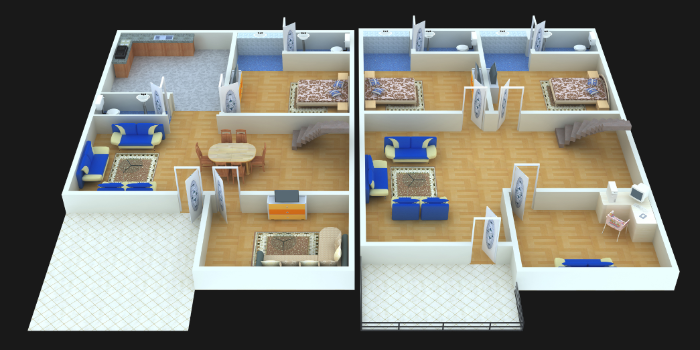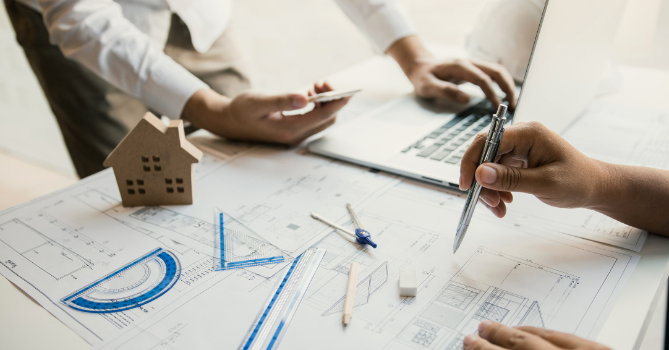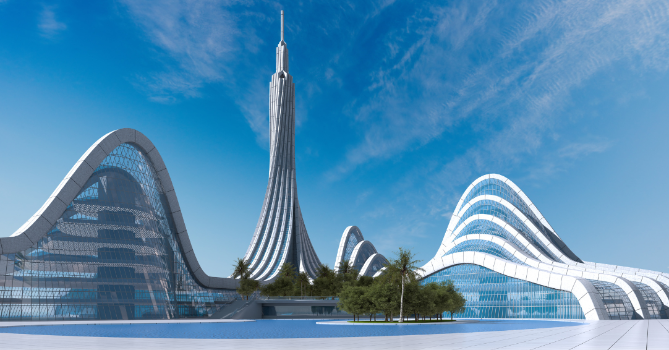
Masters of Stability: How Structural Designers Shape Architecture
Hey there! Ever wonder how those stunning buildings and bridges stay standing tall and strong? Well, it's all thanks to the magic of structural designers. In this blog, we're diving deep into the vital role these unsung heroes play in making architectural dreams a reality.
From skyscrapers to stadiums, every awe-inspiring structure starts with a vision. But turning that vision into a safe and sturdy reality takes a special kind of expertise. That's where structural designers come in. They're the wizards behind the scenes, using their knowledge of physics, math, and materials to craft the bones of our built environment.
So, buckle up as we explore the fascinating world of structural design. Get ready to uncover the secrets behind those breathtaking buildings and gain a newfound appreciation for the unsung heroes shaping our skyline. Let's dive in!
In the world of architecture, teamwork makes the dream work. Architects and structural designers are like peanut butter and jelly – they just work better together. Collaboration is the name of the game, with architects bringing the creative flair and big ideas, while structural designers add the technical know-how to make those ideas a reality.
Picture this: an architect sketches out a jaw-dropping design for a futuristic skyscraper. It's sleek, it's modern, it's... gravity-defying. But before it can become more than just a drawing, it needs to pass the structural designer's test. They work hand-in-hand, brainstorming ideas, sharing feedback, and finding the perfect balance between form and function.
Communication is key in this dynamic duo. Architects and structural designers need to speak the same language – or at least have a really good translator. They discuss everything from load-bearing capacities to building codes, ensuring that the final product is not only stunning but also safe and sustainable.
But it's not always smooth sailing. Sometimes, disagreements arise, like when the architect wants a building to look like a giant glass bubble, and the structural designer worries it might collapse in a stiff breeze. But through compromise and creative problem-solving, they always find a way to make it work.
In the end, it's this collaboration that brings architectural visions to life. Together, architects and structural designers turn dreams into concrete (literally) realities, leaving their mark on the skyline for all to see. So here's to teamwork – the secret ingredient behind every architectural masterpiece.

Now, let's get into the nitty-gritty of structural design – the stuff that makes buildings stand tall and bridges span wide. It's all about combining art with science, creativity with calculations, to create structures that not only look good but also stay standing for generations to come.
First off, let's talk about load-bearing calculations. Ever wonder how buildings support their weight without crumbling like a house of cards? That's where structural designers come in. They crunch the numbers to figure out how much weight a building can handle, taking into account everything from people walking around to heavy furniture and strong winds.
But it's not just about brute force. Structural designers also need to think about materials – what's the best choice for each project? Concrete, steel, wood – each has its strengths and weaknesses, and it's up to the structural designer to pick the perfect fit. They consider factors like cost, durability, and environmental impact, aiming to strike the ideal balance between form and function.
And let's not forget about structural analysis. This is where things get really fancy. Using advanced computer software, structural designers simulate how a building will behave under different conditions – earthquakes, hurricanes, you name it. It's like playing a high-stakes game of Jenga, but with a lot more at stake.
But it's not all about numbers and algorithms. Structural design is also an art form. It's about finding beauty in simplicity, elegance in efficiency. A well-designed structure isn't just strong – it's a work of art, inspiring awe and admiration in all who behold it.
So, next time you walk past a skyscraper or drive over a bridge, take a moment to appreciate the technical mastery behind it all. It's the result of countless hours of hard work, creativity, and ingenuity – all coming together to create something truly remarkable. And it's all thanks to the unsung heroes of structural design.
In the world of structural design, challenges lurk around every corner. From tight budgets to tricky terrain, there's always something standing in the way of turning vision into reality. But with a bit of ingenuity and a whole lot of elbow grease, structural designers are masters at navigating these obstacles and finding solutions that work.
One common challenge is budget constraints. Clients want the Taj Mahal on a shoestring budget – who can blame them? But it's up to structural designers to make it happen. They get creative, finding ways to cut costs without sacrificing quality or safety. Maybe it means using cheaper materials or simplifying the design – whatever it takes to make the numbers work.
Then there's the issue of conflicting design objectives. The architect wants a building that's sleek and modern, while the client is dead set on something more traditional. It's a classic case of too many cooks in the kitchen. But structural designers are the ultimate peacemakers, finding common ground and blending conflicting visions into a cohesive whole.
And let's not forget about regulatory hurdles. Building codes, zoning laws, environmental regulations – they're enough to make your head spin. But structural designers know the rules inside and out, ensuring that every project meets or exceeds all legal requirements. It's all about dotting the i's and crossing the t's, making sure nothing slips through the cracks.
But despite the challenges, structural designers thrive under pressure. They're problem-solvers by nature, turning roadblocks into opportunities and dilemmas into triumphs. So the next time you find yourself facing a seemingly insurmountable obstacle, just remember – if structural designers can build a skyscraper on a budget, you can tackle anything life throws your way.

The future of structural design is brighter than ever, with technology leading the way to new frontiers. From 3D printing to artificial intelligence, the possibilities are endless – and the results are nothing short of revolutionary.
One of the most exciting trends is Building Information Modeling (BIM). This digital modeling technique allows architects and structural designers to collaborate in real-time, streamlining the design process and catching potential issues before they become costly problems. It's like having a crystal ball that lets you see into the future of your building – and fix any mistakes before they happen.
But it's not just about digital tools – materials are getting a makeover too. With advances in nanotechnology and biomimicry, engineers are creating new materials that are stronger, lighter, and more sustainable than ever before. Imagine buildings that repair themselves, or bridges that can withstand earthquakes with ease – it's not as far-fetched as you might think.
And let's not forget about sustainability. As the world grapples with the challenges of climate change, structural designers are leading the charge toward a greener future. From passive design strategies to renewable energy systems, they're finding innovative ways to reduce the environmental impact of our built environment.
But perhaps the most exciting part of all is that we've only scratched the surface. With each new discovery and breakthrough, the possibilities for structural design are endless. So buckle up – the future of architecture is looking brighter than ever, and structural designers are leading the way into a bold new era of innovation and creativity.
Sustainability isn't just a buzzword – it's a game-changer in the world of structural engineering. As the global community wakes up to the realities of climate change, there's an increasing emphasis on building greener, more eco-friendly structures. And structural engineers are at the forefront of this green revolution, pioneering innovative techniques and materials that minimize environmental impact while maximizing efficiency.
One of the key ways sustainable design practices are reshaping structural engineering is through the use of renewable materials. Traditional building materials like concrete and steel are major contributors to carbon emissions, but engineers are finding ways to swap them out for greener alternatives. From bamboo and timber to recycled steel and concrete, there's a whole world of sustainable materials waiting to be explored.
But it's not just about what buildings are made of – it's also about how they're designed. Sustainable structural engineering isn't just about making buildings that use less energy – it's about making buildings that produce their own energy. Engineers are incorporating passive design strategies like natural ventilation, solar panels, and green roofs to reduce reliance on fossil fuels and minimize carbon footprint.
And let's not forget about the long-term benefits of sustainable design. By creating buildings that are more energy-efficient and environmentally friendly, structural engineers are helping to future-proof our cities against the impacts of climate change. From reducing urban heat islands to mitigating flooding and storm damage, sustainable design practices are making our cities more resilient and livable for generations to come.
In short, sustainability isn't just a trend – it's a fundamental shift in how we approach structural engineering. And as we look to the future, it's clear that sustainable design practices will play a central role in shaping the built environment for years to come.
Wrapping up, the world of structural design is a fascinating blend of art, science, and innovation. From collaborative dynamics to technical mastery, navigating challenges, and embracing future trends, structural designers are the unsung heroes behind the skyline. As we've explored, their role is pivotal in shaping architectural marvels that stand the test of time.
But it's not just about creating beautiful buildings – it's about creating sustainable, resilient spaces for future generations. With a focus on sustainability and green practices, structural engineers are leading the charge toward a more eco-friendly future.
So, the next time you marvel at a towering skyscraper or cross a majestic bridge, take a moment to appreciate the incredible work of structural designers. Their passion, creativity, and expertise are what make our world a more beautiful – and safer – place to live. Here's to the unsung heroes of structural design, shaping our world, one beam at a time.